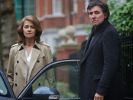Eye For Film >> Movies >> I, Anna (2012) Film Review
I, Anna is very much a Rampling family vehicle. The psychological film noir not only stars veteran actor Charlotte Rampling, but is the directorial debut of her son, Barnaby Southcombe. At the time of writing it has been swiftly snapped up by NFP in Germany and Artificial Eye in the UK ahead of its world premiere at Berlin Film Festival. Given the Rampling family pedigree there are certain expectations of quality, and Southcombe largely lives up to the promise with this sharply stylish crime mystery that gives plenty of space for Rampling to flex her acting muscles. It's not perfect, but as a debut it is not a bad way to make a first impression.
Charlotte Rampling plays divorcee and mother Anna Welles, whom we see is eking out a comfortably middle-class life in a tiny apartment in London following the departure of her husband. Encouraged by her daughter Emmy (Hayley Atwell), she is trying her hand at singles party events in town. One night she meets the flamboyant and wealthy George Stone (Ralph Brown) and goes home with him.

When we next see her, Anna is leaving his apartment block in the Barbican, and heading back up the opposite way is weary night-owl Detective Bernie Reid (Gabriel Byrne). Reid isnt there on a visiting trip though - he has been called to the scene of a brutal murder that took place in the very apartment that Anna has left. Something clearly happened in that apartment, something that left Stone dead. But it's not clear what went down, and how Anna is involved.
Bernie notices Anna leaving, and curious, he tracks her down and follows her to a singles party night where finally they meet, Bernie concealing at first that he sees her as being connected to the case. The mutual attraction is instant, perhaps unsurprising given their similar, lonely existences. Anna seems not to remember or acknowledge that she was ever at Stone's apartment. But as clues start to point towards Anna’s involvement in the murder Bernie finds himself more and more compromised, and Anna's deeply buried memories start to surface and overwhelm her. The fragmented shards of remembrance inside Anna's mind begin to coalesce, allowing the viewer to piece together - alongside Bernie - not only what happened that night but exactly what else Anna might be hiding, or hiding from.
Southcombe’s screenplay is based on the novel I, Anna by Elsa Lewin. The story was designed to pay homage to film noirs where ambiguous and obsessive relationships are more of the concern than more technical procedural aspects. Southcombe has certainly done his noir homework. This is a film drenched in the essence of the genre and the result is, perhaps deliberately, a certain timeless flavour to the setting and story despite the cell phones and speed dating. Note the familiar elements - the ambigious femme fatale (Rampling frequently wears a trenchcoat, too), the night-owl detective banished to a hotel room following a divorce, the unsolvable murder thatinvolved a nearby heavy blunt art object. The motifs are all present and correct.
Noir stories tend to need cities as their playgrounds, and London is as much as star in Southcombe's film as Byrne and Rampling. His camera movements, lighting and framing treat the city as if it were a neon-lit femme fatale too, coldly beautiful as the lens glides over her at night in glorious high definition. The colour pallette, costumes and set dressings paint a blue and gunmetal grey canvas, almost as if the sun casts only metallic light.
Characters are frequently shot in chiarascuro against windows or lights, the camera framing them through windows or gaps in walls, gliding like an interloper around corners to find them. The tower blocks of the Barbican and Canary Wharf are boldly framed to loom over the characters and scenes like watchtowers. Southcombe has a sharp eye for intriguing locations that sometimes borders on the outright gothic or expressionistic - whether it is the Barbican's bizarre Brutalist architecture or the strange bank vault of an office that Bernie resides in. It's all so stylish it is almost distracting - this experiment might not work for some.
Possibly over-stylised for some tastes it, but films such as Drive have shown that a clear directorial vision guiding a talented cast can allow a visually striking film to sidestep the 'style over substance' trap. Southcombe's film at times feels as though it would have worked better as a short film or TV movie, and like many crime films has at its heart a slight story upon which a constructed mood can be hung. But it is, by and large, an immersive, atmospheric homage/pastiche that benefits from having Byrne and Rampling, two veterans who can make reading the phone book look interesting, playing at old noir stereotypes.
Reviewed on: 13 Feb 2012


















